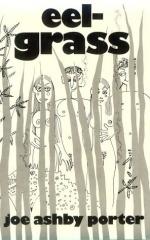|
This section contains 352 words (approx. 2 pages at 300 words per page) |
Eelgrass is the common name for a genus of perennial grasslike flowering plants referred to as Zostera. Zostera is from the Greek word zostermeaning belt, which describes the dark green, long, narrow, ribbon shape of the leaves that range in size from 20 to 50 cm in length, but can grow up to 2 m. Eelgrass grows under water in estuaries and in shallow coastal areas. Eelgrass is a member of a group of land plants that migrated into the sea in relatively recent geologic times, and is not a seaweed.
Eelgrass grows by the spreading of rhizomes and by seed germination. Eelgrass flowers are hidden behind a transparent leaf sheath. Long filamentous pollen is released into the water, where it is spread by waves and currents. Both leaves and rhizomes contain lacunae, which are air spaces that provide buoyancy.
Eelgrass grows rapidly in shallow waters and is highly productive, thus providing habitats and food for many marine organisms in its stems, roots, leaves, and rhizomes. Eelgrass communities (meadows) provide many important ecological functions, including:
- anchoring of sediments with the spreading of rhizomes, which prevents erosion and provides stability
- decreasing the impact of waves and currents, resulting in a calm environment where organic materials and sediments can be deposited
- providing food, breeding areas, shelter and protective nurseries for marine organisms of commercial, recreational, and ecological importance
- concentrating nutrients from seawater that are then available for use in the food chain
- serving as food for water fowl and other animals such as snails and sea urchins
- as detritus (decaying plant matter), providing nutrition to organisms within the eelgrass community, in adjoining marshes, and in offshore sinks at depths up to 30,000 feet.
Eelgrass growth can be adversely impacted by human activities, including dredging, logging, shoreline or over-water construction, power plants, oil spills, pollution, and species invasion. Although transplantation projects designed to restore eelgrass meadows have been initiated on both coasts of the United States, creation of a large-scale meadow with the complex functions and relationships of a natural eelgrass system has not yet been achieved.
Resources
Other
Gussett, Diana.Eelgrass.Port Townsend Marine Science Center. [cited May 27, 2002].
|
This section contains 352 words (approx. 2 pages at 300 words per page) |


